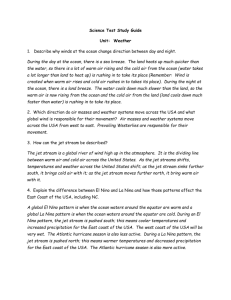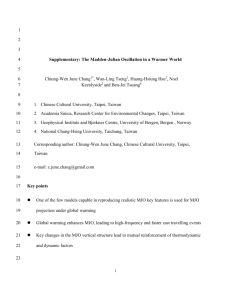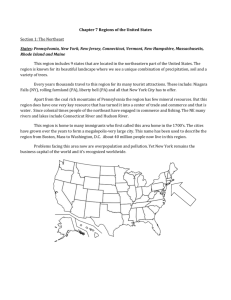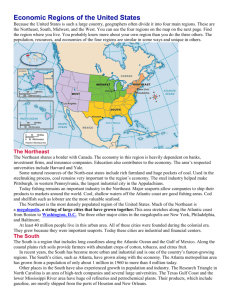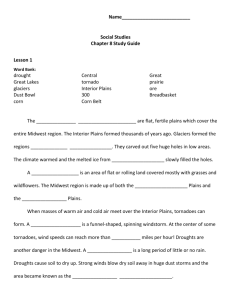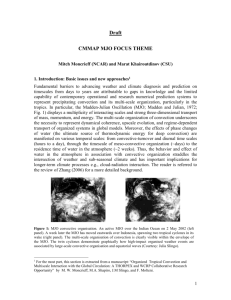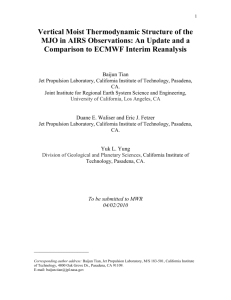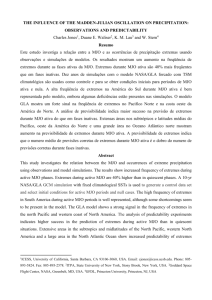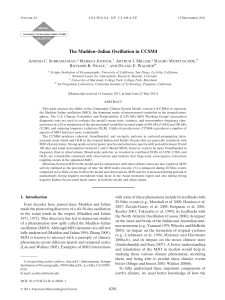AUG66 - WxRisk.com
advertisement
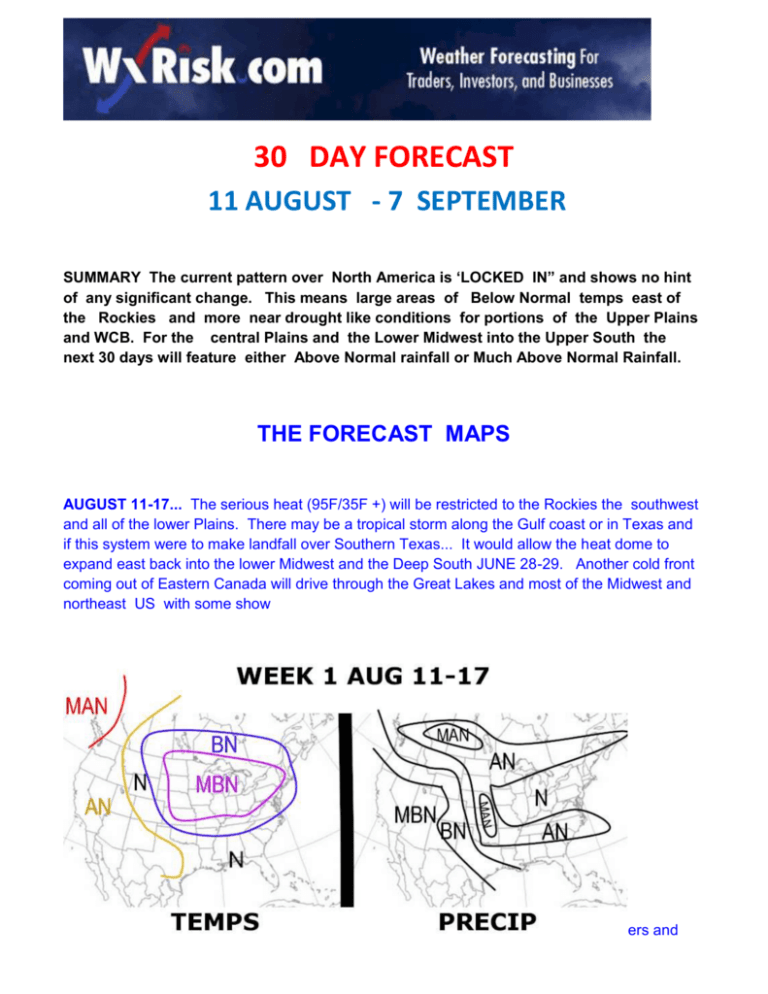
30 DAY FORECAST 11 AUGUST - 7 SEPTEMBER SUMMARY The current pattern over North America is ‘LOCKED IN” and shows no hint of any significant change. This means large areas of Below Normal temps east of the Rockies and more near drought like conditions for portions of the Upper Plains and WCB. For the central Plains and the Lower Midwest into the Upper South the next 30 days will feature either Above Normal rainfall or Much Above Normal Rainfall. THE FORECAST MAPS AUGUST 11-17... The serious heat (95F/35F +) will be restricted to the Rockies the southwest and all of the lower Plains. There may be a tropical storm along the Gulf coast or in Texas and if this system were to make landfall over Southern Texas... It would allow the heat dome to expand east back into the lower Midwest and the Deep South JUNE 28-29. Another cold front coming out of Eastern Canada will drive through the Great Lakes and most of the Midwest and northeast US with some show ers and AUGUST 18-24... A The Heat dome/ ridge will get forced back into the Rockies the southwest states and the central lower Plains where it will remain beastly hot . However with the high latitude blocking over Eastern Canada... the jet stream will be forced south ... coming over the top of the Heat dome in the Rockies into the Midwest . This could set up a series of " Ring of fire". thunderstorm clusters which will bring SOME areas moderate to significant rains over ND SD MN WI MI IA ILL IND KY and / or OH AUGUST 24-31... It is not only the MJO phase 3 July historical data that strongly supporting wetter the normal conditions over the Midwest ... several runs of the CFS weekly forecast Models are now also showing at least slightly wetter than normal conditions over the Midwest for the first time in a few months. Again I do not know what this point how wet it will become over the Midwest... But I do think the week of July 8 - 14 will see the wettest interval in the last few months over the Midwest. . SEPT 1-7. Assuming that the current MJO impulse continues moving steadily through the quadrants / phases.. THEN the MJO could be in phase 4 in this time period which also supports a fairly wet period for the Midwest... But not nearly as much as phase 3. DISCUSSION For the first six months of the year one of the primary driving factors in the overall weather patterns across North America has been the MJO. ( Madden Julian Oscillation). For those of you who are not familiar with this particular phenomena ... the MJO is a weather feature which consists of large areas of heavy thunderstorms that develop over the equatorial regions of Indian and far western Pacific Ocean. There are eight particular phases or cycles to the MJO with each one of these phases corresponding to a particular type of weather patterns across North America depending on whether it is the Winter …Spring …Summer or…Autumn season. The tricky part of course is that the MJO does not move in a straight line. Sometimes the MJO will be tracking from phase 6 and Phase 7 then stop and linger and in Phase 7 or reverse direction or even from time to time fall apart and move into the " neutral zone" . During the first six months the year the MJO persistently spent the majority of its time in the Phases 7 8 1 2 and 3.... which is one of the reasons why the pattern was persistently wet and why the Spring 2013 was delayed. However starting in late June and July the MJO fell apart and it has persistently been stuck in " NEUTRAL" ( called the circle of death in the weather biz) since early July . When that happens it means that the weather pattern at the time the MJO collapsed will likely to be the persistent for dominating weather pattern. In this case the weather patterns in late June and early July featured a persistent large trough over the Midwest and East coast and large Ridge in the Jet stream over the West coast of North America. Now with respect to actual weather conditions here on the surface... this pattern meant Below Normal temperatures (relative to July of course) for the Midwest and the East Coast... Near normal temperatures over the Deep South... and Hot and Dry over the Rockies and the West Coast . With respect to rainfall this sort a pattern would produce significant reins east the Mississippi River but for the Upper Plains and WCB the cold front would have a hard time generating enough moisture as they move through these areas and this would tend to bring about below normal rainfall patterns to those areas. Indeed this is exactly what the overall weather pattern and trends have been since early July. The near drought conditions which have developed over portions of western/ central IA northern MO and portions of the Upper Plains is well known by all. And equally important of course has been the persistent lack of sustained Normal and / or Above Normal temperatures over the Midwest. The other implication of this weak or Non existent MJO is that it allows a the weather features to take over and become the dominant driver of the weather pattern. Sometimes this can be a developing La Nina or El NIno or perhaps a blocking pattern over eastern Canada can become the dominating or driving feature for the weather pattern over North America. But during JULY there was a significant change in the sea surface temperature anomalies (SSTAs) over the Northeast Pacific Ocean. This recent image shows the SSTAs over the North hemisphere and I have highlighted the two important features. First notice the large area of bright orange and red color which represents warm sea surface temps over the north central and northeast portions of the Pacific Ocean. This is a huge change from what the Spring of 2013 when the ocean water temperatures off the West coast of Canada were Much Below Normal. The SECOND area of importance is the buildup of warm SSTAs in the northwest and north central Atlantic Ocean. It has now been long established that large areas of Above Normal and Below Normal SSTAs an and do affect the overall Jetstream patterns. In this case the appearance of these large bodies of warm water are altering the jet stream and locking the current patter in place. As this image shows the jet stream has developed a bulge or RIDGE in Western Canada and a corresponding TROUGH over the Midwest.... followed by a RIDGE over the immediate East coast/ northwest Atlantic ocean. This image shows how the Jetstream pattern closely matches the SSTAs configurations. This is a critical development in figuring out the weather patterns for August and possibly into September as well. If you go back in time and take a look at all the previous months of JULY with similar large buildup of warm water in the northeastern Pacific Ocean... and see what the surface temps were over North America you come up with THIS map (in the weather biz this is called the analog method of seasonal forecasting). As you can see this show a pretty strong correlation between that buildup will warm ocean where temperatures in the northeastern Pacific Ocean and below normal temperatures across most of the Midwest during the month of August. If these warm more temperatures persist throughout the month of August... IF….then we see this sort of analog with respect to surface temperatures for the month of September. Yes that is impressively cold and this sort a pattern increases the threat of a early frost developing in late September across some portion of the upper plains and /or Midwest. Of course we do NOT know… yet… if these warm water temperatures in the northeastern Pacific Ocean will persist for the month of August. It is entirely possible that these warm SSTAs could weaken or dissipate by August 30. There are ways however all following does and this image from the STORMVISTA.COM web site shows the trend over the last 30 days with respect to SSTAs that are warming and / or cooling. Clearly as we can see the warm SSTAs are NOT weakening. Now…If we continue to speculate a little bit about September-- and I will do a lot more about the autumn and the frost potential NEXT week what I do the autumn forecast -- the one wildcard factor which could throw things off with respect to an early frost would be the MJO suddenly becoming active and moving into a one of the Phases which corresponds to warm or above normal temperatures over the plains and Midwest ( Phase 4 5 and 6). There is no indication of any such development but it still way too early to know. David Tolleris ( DT) 804 715 8330 804 307 8070 http://wxrisk.com email wxrisk@comcast.net https://www.facebook.com/WxRisk ======================================================== HOW THESE FORECASTS ARE PREPARED Contrary to more popular opinion... Extended and 30 day forecasting is not simply guess work. There been some significant developments over the past 15 years with regard to forecasting out to 30 days. Despite these new techniques however the number one consideration has to do with expectations. No matter what sort of new techniques and methods have been developed... or will be developed over the next 20 years... it is not possible to accurately forecast Min and Max temperatures in WEEK 3 and WEEK 4 time frame. Truth be told ...that even though there are sites on the Internet which will give you a specific temperature range at day 8 or day 11... the fact of the matter is that those temperature forecasts are simply computer generated numbers that are dry from a flawed weather model. The point is that as long as we keep in mind that it is not possible to get detailed Min and Max temperatures past day 10 with any degree of accuracy... then extended forecasting up to 30 days can be done. There are several long range from weather models which had been in existence for some time and for most of the past 10 years these models have been pretty close to worthless. However last year there was a major upgrade to one of the computer models and the folks over at CPC are now running this model (CFS version 2.0) every day or every other day. Not only has the research showing that the upgraded CFS to be significantly more accurate but by a running the model every day TRENDS can be detected. These trends can enhance a forecasters skill when it comes time to issuing the new 30 day forecast. THE MJO -- Madden Julian Oscillation. This weather phenomenon has a wide ranging and an important impact on evolving weather patterns. It has been known for decades that weather patterns sometimes repeat but the pattern is never exactly the same. And it has been known of course that the jet stream... both the polar jet and the subtropical jet... oscillates and modulates back and forth across the northern and southern hemispheres. The significance of the MJO phenomena is that it gives skilled forecasters a way of anticipating future patterns beyond the range of a 10 or 14 day computer model. Without getting too technical the MJO is a large area of thunderstorms (convection) which develops in the eastern Indian Ocean in and around Indonesia and moves eastward along the equator towards the international dateline and eventually towards Peru along the equator. The movement an intensity of the convection sends out shock waves of energy into the atmosphere both in the northern and southern hemispheres which causes the Jetstream to oscillate in evolve. The MJO has 8 phases and each one of these phases support a particular proper weather pattern over various portions of the northern hemisphere-- North America Asia and Europe. However the MJO in say Phase 5 in February Correlates to a particular type the weather pattern over North America but Phase 5 in July correlates to a vastly different type of weather pattern. SSTAs-- Sea Surface Temperature Anomalies. Large areas of warm and cold sea surface temperatures anomalies do have the impact on weather patterns and specifically the position of mean ridges and troughs with respect to the large scale pattern. For example persistent areas of very cold water and the Eastern Pacific Ocean strongly favors a trough over the eastern Pacific and the West Coast and this in turn favors some sort of Ridge over the eastern or southeastern U.S. Another example will be large areas of very warm water located off the southeast coast of Brazil. This sort of anomaly would favor warmer and potentially dry the normal conditions over southeastern Brazil. SOIL MOISTURE TRENDS... One of the most overlooked aspects of long-term and seasonal forecasting has to do with soil moisture. Large areas of very dry soil conditions-- DROUGHT are known to affect weather patterns. In a similar manner large areas of super saturated soils also affect overall patterns with respect to where the mean trough or mean Ridge position. For example back in the SPRING 1995 developing drought conditions over the Midwest strongly favored saying a hot and fairly dry summer of 1995 over the Midwest and the Northeast. In a similar manner the severe drought in the Spring and Summer of 2011 over Texas helped make it the hottest summer on record for that area.
